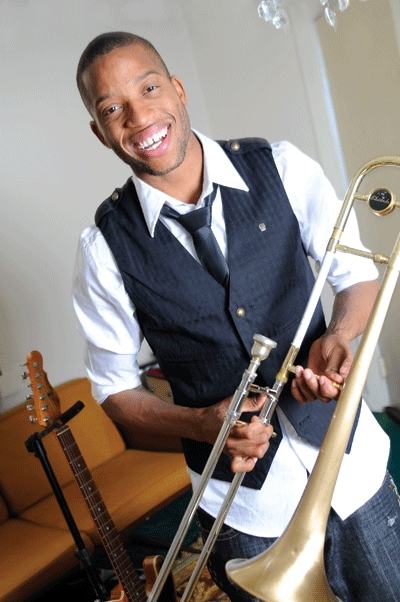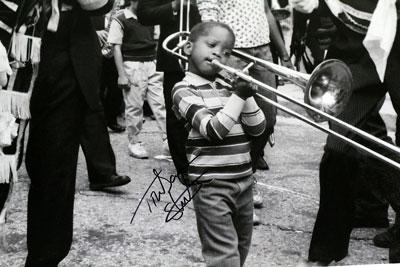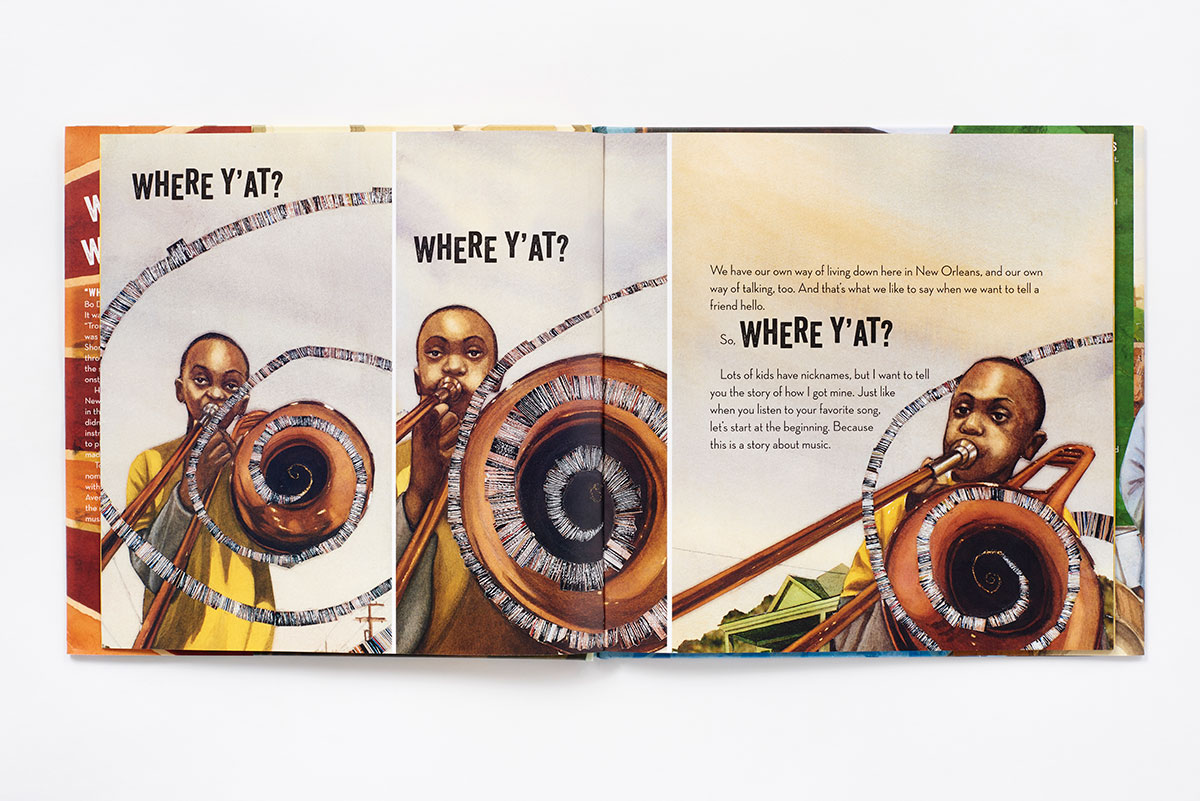
Illustrated by Bryan Collier
June 13, 2018
 Troy Andrews is a jack of all trades. He is an actor, musician, author, and producer out of New Orleans, Louisiana. As a young child growing up in Treme, music was an important art in the community. There would be festivals with loud music and people dancing and singing. Troy along with his brothers joined a bang. Troy was so influenced with the trombone that at a music festival he had the chance to go up on stage with Bo Diddley. Troy got the nickname ‘Trombone Shorty’ from his brother because he was such a small boy playing such a large instrument. Troy has had the honors of working some some of musics finest: Aerosmith, Lenny Kravitz, Jeff Beck and so many more. He now has foundation, The Trombone Shorty Foundation, in honor of young kids with a passion in New Orleans music that may be underprivileged but have big dreams in music. This foundation helps kids obtain instruments to peruse their dreams.
Troy Andrews is a jack of all trades. He is an actor, musician, author, and producer out of New Orleans, Louisiana. As a young child growing up in Treme, music was an important art in the community. There would be festivals with loud music and people dancing and singing. Troy along with his brothers joined a bang. Troy was so influenced with the trombone that at a music festival he had the chance to go up on stage with Bo Diddley. Troy got the nickname ‘Trombone Shorty’ from his brother because he was such a small boy playing such a large instrument. Troy has had the honors of working some some of musics finest: Aerosmith, Lenny Kravitz, Jeff Beck and so many more. He now has foundation, The Trombone Shorty Foundation, in honor of young kids with a passion in New Orleans music that may be underprivileged but have big dreams in music. This foundation helps kids obtain instruments to peruse their dreams.
Awards
- Heinz Award in the Arts if Humanities
- Coretta Scott King Book Award
Book Summary
This story takes place in Treme, Louisiana with a little boy by the name of Troy Andrews. Troy, who also narrates his story, Trombone Shorty, grew up loving music and rightfully so. Music is an important cultural representation of the people in Treme. Troy can hear music from left to right of people playing instruments for people all around. Troy even listened to music in his house, while his big brother practiced the trumpet for his band.
Troy and his brother would love when the Mardi Gras parade would come into town. Troy loved seeing the different types of instruments that created such wonderful sounds to gather people. This is when Troy knew, he wanted to create music. The few of people joining around and leaving their trouble away, made him feel good.
So,he searched for an instrument to make this reality. He and his friends found broken instruments and the one that caught Troy’s eye was a trombone. One day, while the Mardi Gras parade was in front of his house, he grabbed his trombone and started to play too. His brother saw this and said, “Trombone Shorty” because the trombone was twice the size of him.

From this day on, Troy would take his trombone with him everywhere he went. He knew it was too big for him, but he didn’t care. Troy taught himself how to properly hold it, so he wouldn’t tip over. He would also listen to his brother play the same songs, which he taught himself to play. His mom caught sight on how much he loved playing and listening to Jazz music. She bought Troy tickets to the New Orleans’s Jazz Festival.
This is where Troy got to play on stage with infamous, Bo Diddley. The joy and excitement that he got from being on stage, lit a spark in Troy. He knew he loved music and needed to continue playing. So, he and his friends formed a band called, “The Five o’Clock Band” because they would always practice at 5 o’clock. This turned into Trombone Shorty joining his brother’s band, “Trombone Shorty and Audience Avenue.”
Trombone Shorty and Audience Avenue have had the chance to play all around the world, but Trombone Shorty would always come right back to Treme. He thought it was important to teach young believers, if they have a dream, they needed to go chase it.

Author’s Language

The author did a wonderful job incorporating the Louisiana dialogue. He used the phrase, “Where Ya At?” multiple times, which means, hello. I thought this was a great way for the author to illustrate the atmosphere of the Louisiana language.
Figurative Language:
- The author uses a metaphor comparing music to gumbo. On page 27, he says, “We call it gumbo and that’s what I wanted my music to sound like-different styles combined to create my own musical gumbo.” I love that he used this comparison because gumbo is such a tasteful representation of Louisiana food as well as Jazz is also a wonderful representation of their music.
- He also uses a simile when he compared was describing the visual for how the tuba reminded him of an elephant’s trunk, saying “the biggest brass instrument of them all, the tuba-which rested over the musicians’s head like an elephant’s trunk.”
Instructional Lessons
I would use Trombone Shorty to begin our traditions unit before winter break. Troy Andrews did a great job incorporating food (gumbo), music (Jazz), and people ( Bo Diddley), to the Louisiana culture. This can be a great visual and reminder for young writers what are important details in during traditions unit. This can also create enrichment a child’s life because maybe they are from New Orleans and have a connection to Mardi Gras. This can also enrich classroom diversity because they can each represent themselves in different ways.
Mentor Text
As a primary teacher I love using a variety of texts to help facility learning. This text would be used in the following ways
Stem: I would for the kids to use: paper, pipe-cleaners, cardboard, or legos to create their own instruments.
Theme: This book was mostly about chasing your dreams no matter your background. I would love to use this book as introducing theme or as another mentor text supporting theme.
Author’s Purpose: In first grade, author’s purpose is a big literature skill to know. I would love to see what the kids explain their thinking and defend their answers.
I do not have any concerns with this book.
Extension Questions
- Are minorities shown exclusively in poverty situations?
-Troy Andrews doesn’t mention literally he was in impoverished situations, but he mentions how he found a broken trombone and uses it to practice. This makes me infer that his family was not as well off to buy him one.
- What visuals and text-evidence can students use to make inferences about the culture in this book?
-Students can use the many instruments seen on each page, illustrated by Bryan Collier, and also see the smiles of each of the character’s faces that the people in this book love their culture. They can also use the text evidence of musical parades and high energy to infer that both adults and kids play a role in Jazz-music, which is something they enjoy.
- What attitudes are shown toward people, animals, and even the land?
-The attitudes of the people in this book are illustrated and explained as proud and joyful. Troy Andrews uses the phrase, “Where Ya At” which embraces Louisiana’s cultural-language to show specials uniqueness of this culture. The people in this story also seem happy and excited about the parades. He goes to tell, people gather around and forget about their problems. This tells the reader they are a strong community to can all relate to music.
Hi again Charissa,
I am so glad that you noticed the positive use of regional/local dialect – very powerful to see the main character proudly use his dialect. This lends itself to a discussion about ADDING standard English to one’s linguistic repertoire instead of replacing one’s dialect with standard English. Also, I love that you already have thought about where you could use this book – in the traditions unit! I hope you do use it AND expose students to a few short video clips of TS in his youth and playing as an adult!
Sherry Taylor
LikeLike